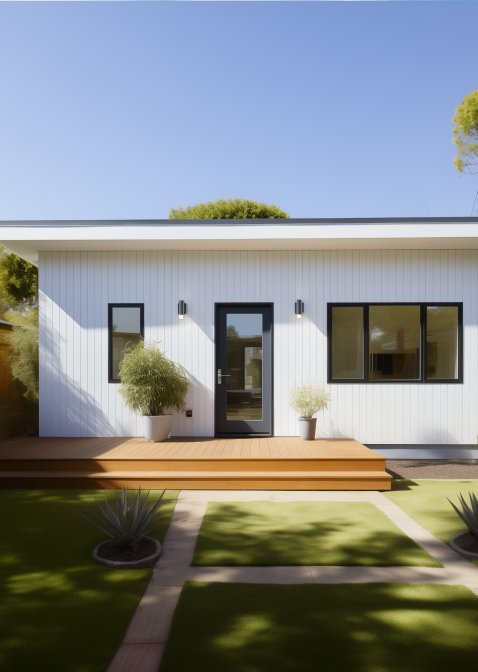In America the housing market has always been of utter importance. The county’s population grows and with it grows the demand for versatile and affordable living spaces. Hence, shipping container Accessory Dwelling Units (ADUs) present an innovative and sustainable solution. These unique buildings repurpose shipping containers, transforming them into functional and customizable living quarters. The reason why shipping container ADUs are popular is a testament to their numerous advantages, including cost-effectiveness, durability, and eco-friendliness.
This article aims to explore the advantages and disadvantages of building such ADUs and provide valuable tips for those considering this unconventional approach to the construction. By understanding the intricacies of such ADUs, homeowners can make informed decisions on choosing this ADU type.
Shipping container ADUs offer several advantages that have contributed to their growing popularity among homeowners seeking innovative and rather cheap living options.
Here are some notable pros of building an ADU with shipping containers:
In summary, shipping container ADUs offer an appealing combination of affordability, durability, and eco-friendliness, making them a popular choice for homeowners seeking to expand their living space without breaking the bank or the planet.
Despite the numerous advantages of shipping container ADUs, there are also several challenges and drawbacks to consider when opting for this unconventional construction method.
Here are some cons of building an ADU with shipping containers:
Shipping containers come in standard sizes, which can impose limitations on the available living space and overall design of the ADU. This constraint may make it challenging to create spacious and comfortable living areas without combining multiple containers, which can increase the project’s complexity and cost.
Shipping containers are made of steel, which is not an ideal insulating material. This characteristic can lead to difficulties in maintaining a comfortable interior temperature, especially in extreme climates. Adequate insulation and climate control solutions are crucial for ensuring energy efficiency and occupant comfort, which may add to the overall cost and complexity of the project.
Navigating the permitting and zoning regulations for shipping container ADUs can be challenging, as local authorities may have strict requirements or limited experience with this type of construction. Homeowners may need to invest time and effort in researching local regulations and obtaining necessary permits before commencing construction.
Used shipping containers may have been exposed to various chemicals or contaminants during their service life. It is essential to thoroughly inspect and clean the containers before repurposing them for residential use to avoid potential health risks.
Sourcing high-quality, structurally sound shipping containers can be challenging, especially in regions with limited availability. Homeowners may need to invest time and effort in finding suitable containers, which can impact the project timeline and overall cost.
While shipping container ADUs have their drawbacks, many of these challenges can be mitigated through thorough planning, research, and collaboration with experienced professionals. Careful consideration of the cons will enable homeowners to make informed decisions and optimize their shipping container ADU projects.
When embarking on a shipping container ADU project, it is essential to consider various factors and best practices to ensure a successful outcome. Here are some valuable tips for building a shipping container ADU:
Carefully inspect containers for structural integrity, rust, and damage before purchasing. Choose between new or used containers based on your budget and project requirements, keeping in mind that new containers may offer better quality but at a higher cost.
Work with experienced architects or designers to develop a functional and aesthetically pleasing layout that maximizes space utilization and incorporates natural light and ventilation. Consider the unique characteristics of shipping containers and how they can be leveraged in your design.
Invest in high-quality insulation materials and methods to ensure energy efficiency and occupant comfort. Proper insulation will help maintain a comfortable interior temperature and reduce energy consumption for utilities.
Research local regulations and consult with local authorities to understand the permitting requirements and zoning restrictions for shipping container ADUs. This process will help you avoid potential legal issues and ensure your project complies with local regulations.
By following these tips and collaborating with knowledgeable professionals, you can optimize your shipping container ADU project, resulting in a functional, comfortable, and sustainable living space that meets your unique needs and preferences.
To wrap things up, shipping container ADUs are like the swiss army knife of living spaces, offering a creative and unconventional solution for homeowners craving extra room. Boasting a myriad of benefits such as cost-effectiveness, sturdiness, and a green thumb, it’s no wonder these out-of-the-box dwellings have gained quite the fanbase. However, it’s crucial to weigh the potential challenges and hiccups that come with this building method. By sticking to the tips shared in this article and enlisting the help of seasoned pros, you’ll be well on your way to mastering the art of shipping container ADU construction.
In the end, this eco-friendly and adaptable choice has the power to conjure up a functional and eye-catching living space that ticks all your boxes and maybe even a few you didn’t know you had.











